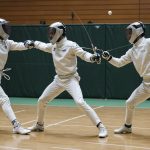Unlock Your Potential: Essential Breathing Strategies to Enhance Performance for UK Karate Athletes
The Importance of Breathing in Martial Arts
When it comes to martial arts, particularly karate, the focus often lies on the physical aspects such as kicks, punches, and stances. However, one of the most critical yet often overlooked components of martial arts training is breathing. Breathing techniques are not just ancillary; they are fundamental to enhancing your performance, mental clarity, and overall well-being.
In the words of Mr. Miyagi from the classic film “The Karate Kid,” “Breathe in through nose, out through mouth. Don’t forget to breathe, very important.”[4] This simple yet profound advice underscores the significance of breathing in martial arts.
Also to read : Unleash your clinch mastery: essential drills for uk muay thai practitioners
Understanding the Science Behind Breathing
Breathing is more than just inhaling and exhaling; it is about optimizing the flow of oxygen to your body. When you breathe correctly, you ensure that your muscles receive the oxygen they need to perform at their best. Here’s a breakdown of how proper breathing can benefit your karate training:
Oxygen Advantage
Proper breathing techniques, such as diaphragmatic breathing, help in maximizing oxygen intake. This type of breathing engages your diaphragm, allowing your lungs to fill more efficiently and providing your body with the oxygen it needs to sustain intense physical activity.
In parallel : Revolutionize UK Boxing: Harness Advanced Tech for Superior Punch Accuracy
Mental Clarity
Breathing exercises are closely linked to mental discipline. Techniques like nasal breathing and Buteyko breathing help in calming the nervous system and enhancing mental clarity. This mental focus is crucial for karate athletes, as it allows them to stay concentrated and make quick, precise decisions during training and competitions[3].
Physical Performance
Breathing techniques can significantly improve your physical performance. For instance, deep breathing exercises can help lower blood pressure and reduce stress, allowing you to perform at a higher level without fatigue. In karate, this translates to better execution of techniques, improved endurance, and enhanced overall performance[3].
Breathing Techniques for Karate Athletes
Different karate styles emphasize various breathing techniques, each with its unique benefits. Here are some of the most effective breathing strategies for karate athletes:
Goju-Ryu Breathing Techniques
Goju-Ryu karate is renowned for its unique integration of hard and soft techniques, and breathing is a central component of this style. Practitioners of Goju-Ryu learn to breathe deeply from their diaphragm, synchronizing each breath with their movements. This creates a powerful synergy between breath and body, enhancing both physical and mental performance.
- Deep Diaphragmatic Breathing: Focus on inhaling deeply through your nose, allowing your diaphragm to drop and your belly to rise. Exhale slowly through your mouth, ensuring your diaphragm rises and your belly falls.
- Tension and Relaxation: Practice switching between states of tension and relaxation, which helps in developing the ability to switch between powerful strikes and fluid blocks[1].
Kyokushin Breathing Techniques
Kyokushin karate, known for its full-contact sparring, requires athletes to be resilient and physically conditioned. The breathing techniques in Kyokushin focus on building endurance and mental toughness.
- Rapid Breathing: During intense sparring sessions, rapid breathing can help in maintaining oxygen flow and reducing fatigue.
- Breath Control During Sparring: Practice controlling your breath during sparring to maintain focus and composure under pressure[1].
Comparative Analysis of Breathing Techniques in Different Karate Styles
Here is a comparative table highlighting the breathing techniques and focus areas of various karate styles:
| Karate Style | Breathing Technique | Focus Areas |
|---|---|---|
| Goju-Ryu | Deep diaphragmatic breathing, synchronized with movements | Flexibility, balance, hard and soft techniques[1] |
| Kyokushin | Rapid breathing, breath control during sparring | Endurance, resilience, full-contact sparring[1] |
| Shotokan | Linear breathing, emphasis on powerful exhalation | Powerful, linear movements, strong stances[1] |
| Wado-Ryu | Quick, controlled breathing, integrating jujitsu principles | Agility, quick footwork, body movement and evasion[1] |
| Shito-Ryu | Balanced breathing, combining speed and solid stances | Versatility, speed, solid stances[1] |
Practical Tips for Incorporating Breathing Techniques into Your Training
Morning Breathing Exercises
Start your day with a simple yet effective breathing routine. Here are some steps to follow:
- Wake-Up Stretching: Begin with light stretching to wake up your muscles.
- Deep Breathing: Practice deep diaphragmatic breathing for 10-15 minutes.
- Basic Techniques: Incorporate basic karate techniques while focusing on your breath.
This morning routine sets a positive tone for the day and helps in improving your focus and physical readiness[3].
Breathing During Training
During your karate training sessions, make sure to:
- Synchronize Your Breath: Synchronize your breath with your movements, especially during kata practices.
- Control Your Breath: Practice controlling your breath during sparring to maintain focus and composure.
- Use Breathing to Manage Stress: Use breathing techniques to manage stress and fatigue during intense training sessions[1].
Home Practice
You don’t need to be in a dojo to practice breathing techniques. Here’s how you can incorporate breathing exercises into your home routine:
- Bodyweight Exercises: Start with bodyweight exercises and basic drills.
- Shadowboxing: Practice shadowboxing while focusing on your breath.
- Meditation and Mindfulness: Incorporate meditation and mindfulness practices to enhance your mental clarity and discipline[3].
Real-Life Examples and Success Stories
Many martial artists have seen significant improvements in their performance and overall well-being by incorporating effective breathing techniques into their training.
Case Study: Goju-Ryu Practitioner
A Goju-Ryu practitioner shared how mastering the unique breathing techniques of this style helped him improve his focus and physical performance. By synchronizing his breath with his movements, he was able to execute techniques more precisely and maintain his energy levels during long training sessions.
Personal Account: Kyokushin Athlete
A Kyokushin athlete credited the rapid breathing techniques and breath control during sparring for his improved endurance and mental toughness. He noted that these techniques helped him stay focused and composed under the intense pressure of full-contact sparring.
Applying Breathing Techniques Beyond the Dojo
Breathing techniques are not limited to the dojo; they can be applied in various aspects of your life to improve your overall well-being.
Managing Stress
Breathing exercises can be a powerful tool for managing stress. Techniques like Buteyko breathing and nasal breathing help in calming the nervous system and reducing stress levels. This can be particularly beneficial in everyday life, helping you navigate challenges with greater ease and composure[3].
Improving Mental Discipline
The mental discipline developed through breathing techniques in martial arts can be applied to other areas of your life. By practicing mindfulness and focus through breathing, you can improve your concentration and mental clarity, leading to better performance in both personal and professional settings[2].
Breathing techniques are the unsung heroes of martial arts training. By mastering these techniques, karate athletes can significantly enhance their physical performance, mental clarity, and overall well-being. Whether you are practicing Goju-Ryu, Kyokushin, or any other style, incorporating effective breathing strategies into your training can help you unlock your full potential.
Remember, as Mr. Miyagi said, “Breathe in through nose, out through mouth. Don’t forget to breathe, very important.” By focusing on your breath, you can transform your training, your performance, and ultimately, your life.
Final Tips and Recommendations
- Set Realistic Goals: Start by setting short-term and long-term goals for your breathing practice. Track your progress to stay motivated.
- Practice Consistently: Consistency is key. Aim for regular practice rather than long, infrequent sessions.
- Integrate Breathing into Daily Life: Incorporate breathing exercises into your daily routine, whether it’s during your morning stretch or throughout your workday.
- Seek Guidance: Find a qualified instructor who can guide you in mastering the breathing techniques specific to your karate style.
By embracing these breathing strategies, you will not only improve your karate performance but also enhance your mental discipline, reduce stress, and live a more balanced and fulfilling life.











